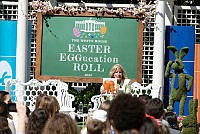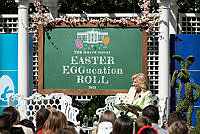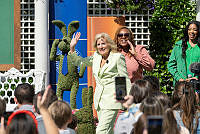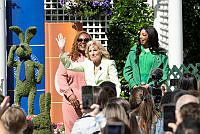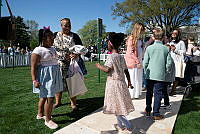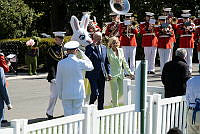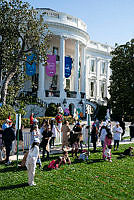Have you ever wondered...
When did the White House host its first Easter Egg Roll?
The first annual White House Easter Egg Roll was held on April 22, 1878 after President Rutherford B. Hayes agreed to open the White House Grounds on Easter Monday. Congress had previously passed legislation to restrict public use of the Capitol Grounds, so children in the nation’s capital looked elsewhere to roll their Easter eggs. Since then, children have gathered annually on the White House South Lawn to roll eggs and participate in Easter activities.
- In 1885, young egg rollers marched into the East Room, hoping for a personal audience with President Grover Cleveland. When he came down from his office to greet them, he was charmed, and egg roll receptions became customary.
- In April 1889, President Benjamin Harrison added music to the Easter Egg Roll, ordering the United States Marine Band, known as "The President's Own," to play lively tunes while the children romped on the South Lawn.
- District of Columbia food administrator Charles Wilson announced on March 3, 1918 that wartime restrictions on food consumption meant that destruction of eggs as part of the Easter Monday Egg Roll could not be allowed, and that the 1918 Egg Roll was cancelled.
- On April 1, 1929, the White House Easter Egg Roll was broadcast on radio for the first time, by station WRC in Washington, D.C.
- With the onset of World War II, the White House Easter Egg Roll was canceled for security reasons in 1942. Officials moved the event to the Capitol Grounds that year, but the egg roll was then suspended for the remainder of the war. Food conservation efforts compelled President Harry S. Truman to cancel the 1946-1948 White House Easter Egg Rolls. From 1949 to 1952, the Truman Renovation of the White House made the South Lawn a construction zone, and the Easter Egg Roll remained suspended.
- In April 1969, the tradition of an official White House Easter Bunny was born when one of First Lady Thelma “Pat” Nixon's staff members put on a white jumpsuit and Peter Rabbit mask and shook children’s hands along the South Lawn’s circular driveway.
- In 1981, President Ronald Reagan and First Lady Nancy Reagan hosted a hunt for wooden eggs that bore the signatures of famous people and wooden eggs soon became the official White House Easter Egg Roll keepsakes.
- In 1998, White House Easter Egg Roll festivities were broadcast live on the internet for the first time, and in 2009, for the first time, tickets to the White House Easter Egg Roll were distributed online.
- There were a number of years—such as 1959, 1964, 1978, 1984, and 2001—that the event was canceled because of inclement weather. In 2020 and 2021, the egg roll was canceled due to the Covid-19 pandemic.

Children participate in the White House Easter Egg Roll on April 19, 1965.
The White House Historical Association





















